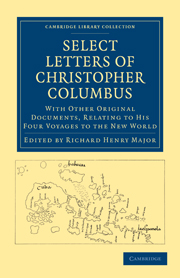 Select Letters of Christopher Columbus
Select Letters of Christopher Columbus Published online by Cambridge University Press: 05 March 2012
Nearly three thousand years have passed since the wisest of men declared that there was nothing new under the sun. The saying has held good to the present day, for men are perpetually finding out that their recent discoveries had been already made, but under circumstances which did not reveal the full value of that which had been discovered. No greater examples of this truth can be adduced than in the history of the Atlantic, of America, and of Australia. Until the days of Prince Henry the Navigator, the Atlantic was so unknown that it justly bore the name of the “Sea of Darkness;” and yet, during the previous two thousand years occasional glimpses of light had in fact been thrown upon the face of that mysterious ocean. “Nil novi sub sole” was still an indisputable proverb. In the researches into the Atlantic originated by Prince Henry, Columbus took part, and hence, as we shall presently more fully see, derived the idea of the great importance of explorations to the West. Within one hundred years of the triumphant rounding by Prince Henry's navigators (in 1434) of Cape Bojador, which till then had been the limit of Atlantic exploration, the Portuguese had discovered both the eastern and western shores of the continental island of Australia. And yet till recently men knew not that they owed the knowledge either of America or of Australia to the initiatory efforts of a Prince with whose name, in fact, they were almost entirely unacquainted.
To save this book to your Kindle, first ensure [email protected] is added to your Approved Personal Document E-mail List under your Personal Document Settings on the Manage Your Content and Devices page of your Amazon account. Then enter the ‘name’ part of your Kindle email address below. Find out more about saving to your Kindle.
Note you can select to save to either the @free.kindle.com or @kindle.com variations. ‘@free.kindle.com’ emails are free but can only be saved to your device when it is connected to wi-fi. ‘@kindle.com’ emails can be delivered even when you are not connected to wi-fi, but note that service fees apply.
Find out more about the Kindle Personal Document Service.
To save content items to your account, please confirm that you agree to abide by our usage policies. If this is the first time you use this feature, you will be asked to authorise Cambridge Core to connect with your account. Find out more about saving content to Dropbox.
To save content items to your account, please confirm that you agree to abide by our usage policies. If this is the first time you use this feature, you will be asked to authorise Cambridge Core to connect with your account. Find out more about saving content to Google Drive.